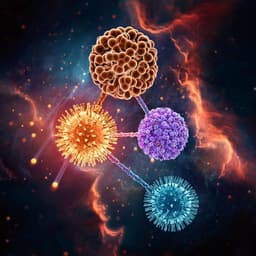
Agriculture
Harnessing phosphonate antibiotics argolaphos biosynthesis enables a synthetic biology-based green synthesis of glyphosate
L. Chu, X. Luo, et al.
This groundbreaking research explores the enhanced production of aminomethylphosphonate (AMP), a vital intermediate in the biosynthesis of the argolaphos antibiotic. Conducted by Leixia Chu and colleagues, the study showcases a sustainable approach to glyphosate production that reduces hazardous waste.
~3 min • Beginner • English
Introduction
Glyphosate (N-(phosphonomethyl)glycine) is among the most widely used herbicides worldwide. Industrial syntheses, primarily via iminodiacetic acid routes or hydrophosphonylation using dimethyl phosphate, rely on toxic reagents and generate hazardous wastes, creating environmental and regulatory burdens. With global production exceeding one million tons annually and ongoing demand from transgenic crop cultivation, there is an urgent need for greener, safer manufacturing. Biocatalysis and synthetic biology enable selective, scalable, and environmentally friendly production of chemicals by reconstructing biosynthetic pathways in tractable hosts. This study asks whether a biosynthetic intermediate of the phosphonate antibiotics argolaphos—aminomethylphosphonate (AMP)—can be produced efficiently by engineered microbes and subsequently converted via a practical, benign chemical process to glyphosate, thereby providing a green alternative to current manufacturing.
Literature Review
Two major industrial glyphosate syntheses (IDA-based and dimethyl phosphate hydrophosphonylation) achieve high yields but employ chlorine, formaldehyde, hydrochloric acid, methanol, phosphorus reagents, triethylamine, and cyanides—compounds listed among hazardous air pollutants. Biocatalytic manufacturing has transformed access to complex molecules (e.g., artemisinic acid, opiates) through pathway elucidation and heterologous expression. Regulatory element interactions in synthetic constructs can hinder predictable gene expression; insulator elements such as RiboJ and SarJ mitigate promoter-RBS crosstalk. Prior work identified argolaphos A and B as phosphonopeptides containing AMP, indicating that AMP is a natural metabolite and potential glyphosate precursor. Enzymes for N5-hydroxylation of arginine are rare, with DcsA and Mhr24 implicated in other natural product pathways; their homologs provide clues for argolaphos assembly. Cytidylyl activation is a common strategy in phosphonate biosynthesis (e.g., fosfomycin, FR-900098, phosphinothricin tripeptide), highlighting conserved logic for pathway tailoring.
Methodology
- Genome mining and gene cluster identification: The Streptomyces monomycini NRRL B-24309 genome was sequenced and annotated (RAST, antiSMASH). A unique 17.6 kbp cluster (alp) with pepM homolog alpH and 15 additional ORFs was identified.
- Heterologous expression: The alp cluster and combinations thereof were assembled via yeast homologous recombination (DNA assembler) into pYES-derived vectors and integrated into Streptomyces lividans 66. Constructs used native promoters, strong promoters (ermE*p, gapdhp from Eggerthella lenta), and later a promoter-insulator-RBS strategy.
- Structural characterization: Argolaphos A absolute configuration was determined by indium-mediated reduction to remove N–O (yield 95%) followed by Marfey’s derivatization and LC-MS comparison to standards, assigning L-arginine and L-valine.
- Pathway dissection and in vitro biochemistry: Six genes alpGHIJKL were proposed for AMP biosynthesis from PEP via PnPy, PnAA, 2-HEP, HMP to AMP. In vitro assays with purified His-tagged enzymes validated steps: AlpH (PEP mutase) + AlpI (PnPy decarboxylase) convert PEP to PnAA with TPP/Mg2+; AlpJ (reductase) converts PnAA to 2-HEP with NADH; AlpG (class II HEPD-like oxygenase) converts 2-HEP to HMP with Fe(II)/O2; AlpK (alcohol dehydrogenase-like) and AlpL (aminotransferase) convert HMP to AMP with NAD+ (or NADP+) and L-glutamate (or L-aspartate). Reactions were monitored by 31P NMR after IMAC/HILIC clean-up.
- In vivo metabolite profiling and transcription analysis: 31P NMR of culture extracts monitored phosphonate intermediates (chemical shift ranges noted). qRT-PCR quantified alpGHIJKL transcript levels under native, ermE*p, and gapdhp promoters relative to hrdB to identify expression bottlenecks.
- Promoter-insulator-RBS engineering: The six genes were divided into two operons (alpGHIJ and alpKL). Insulators (RiboJ for alpGHIJ; SarJ for alpKL) were inserted to reduce feedback/crosstalk. Libraries of eight promoters and eight RBSs were combinatorially paired (64 cassettes) upstream of alpKL to optimize expression; best performers were identified by AMP quantification (UPLC-MS) and 31P NMR.
- Chemical conversion to glyphosate: Two routes from microbially produced AMP were explored. (1) SN2 reaction with haloacetic acids (Cl, Br, I) in aqueous NaHCO3 at 50 or 90 °C for 1–3 h, monitoring yields by 31P NMR. (2) Direct reductive amination of glyoxylic acid with AMP using α-picoline-borane (α-pic-BH3) in H2O/AcOH or MeOH/AcOH at room temperature for 1 h; 31P NMR tracked conversion; yields confirmed and scaled (1 g) with similar results.
- Analytics and quantification: 31P NMR for phosphonate detection; UPLC-HRMS (HILIC) for AMP quantification with validated calibration, LOD/LOQ; LC/MS for structural analyses; standard molecular biology methods for cloning and expression; fermentation in defined media with time-course sampling.
Key Findings
- Genetic basis of AMP biosynthesis: The minimal cassette alpGHIJKL from S. monomycini encodes the complete AMP pathway. Enzyme functions were biochemically validated stepwise by 31P NMR assays.
- Heterologous production and bottlenecks: Initial expression of alpGHIJKL in S. lividans yielded low AMP (~0.15 mg/L) and accumulation of intermediates (2-HEP, HMP). qRT-PCR revealed low transcription of alpK and alpL under native/ermE*p/gapdhp promoters, identifying them as bottlenecks and indicating intracluster regulatory interference.
- Synthetic biology solution: Dividing the pathway into two operons (alpGHIJ and alpKL) and insulating with RiboJ and SarJ eliminated negative feedback and crosstalk, increasing expression of alpKL and balancing flux. A combinatorial promoter-insulator-RBS library upstream of alpKL identified an optimal construct (gapdhp from Rhodococcus erythropolis–SarJ–helicase-associated RBS, P8R8RC), boosting AMP titer to 52.6 mg/L, approximately 500-fold over the original strain, with cultures accumulating only AMP (no intermediates/shunts).
- Chemical conversion to glyphosate: SN2 coupling of AMP with haloacetic acids showed halogen dependence and temperature effects, with iodoacetic acid at 90 °C for 1 h giving ~49.2% glyphosate yield (vs. bromoacetic acid 30.4% and chloroacetic acid 13.0%). Direct reductive amination of AMP with glyoxylic acid using α-pic-BH3 in aqueous acetic acid achieved 96% glyphosate yield at room temperature within 1 h and scaled successfully to 1 g with similar yield.
- Structural context: Argolaphos A contains L-arginine and L-valine; AlpG groups phylogenetically with class II HEPD-like enzymes, consistent with 2-HEP to HMP conversion.
- Environmental significance: The combined microbial-chemical route demonstrates a greener alternative for glyphosate production avoiding highly hazardous reagents prevalent in industrial processes.
Discussion
The study addresses the challenge of environmentally burdensome glyphosate manufacturing by establishing a hybrid biosynthetic-chemical route. By identifying and validating the AMP biosynthetic genes (alpGHIJKL) and resolving expression bottlenecks via a promoter-insulator-RBS strategy, AMP production in S. lividans was elevated to tens of mg/L with clean product profiles. This bio-derived AMP was efficiently converted to glyphosate, with a highly practical and benign direct reductive amination delivering 96% yield under mild, aqueous conditions. The approach demonstrates how synthetic biology can circumvent regulatory complexities within native clusters (through operon division and insulators) to enable robust flux to a target intermediate, while green chemistry completes conversion to the final product. Collectively, the results provide a proof-of-concept greenness-driven alternative that could be developed to meet substantial market demand with fewer toxic inputs and wastes than conventional chemical syntheses.
Conclusion
This work elucidates the full biosynthetic pathway to aminomethylphosphonate (AMP) within the argolaphos gene cluster and demonstrates efficient heterologous production in Streptomyces lividans by breaking regulatory interference using promoter–insulator–RBS engineering. AMP titers reached 52.6 mg/L (~500-fold improvement), and a practical one-step, aqueous reductive amination converted AMP to glyphosate in 96% yield, with an alternative SN2 route also feasible. These advances in pathway engineering and green chemistry establish a foundation for an industrially viable, environmentally friendlier glyphosate production process. Future work may focus on further strain optimization and scale-up, deeper characterization of auxiliary enzymes (e.g., peptide ligases and N5-hydroxylation), and process integration for commercial deployment.
Limitations
- Fermentation titers of AMP (52.6 mg/L) remain well below industrial benchmarks, requiring additional strain and process optimization.
- The inability to perform gene knockouts in the native S. monomycini hindered in situ functional validation; conclusions relied on heterologous expression and in vitro assays.
- Regulatory complexity within the gene cluster necessitated engineered operon division and insulators; broader applicability across hosts and conditions requires further verification.
- Enzymes responsible for certain tailoring steps (e.g., peptide bond-forming ligases in argolaphos assembly) and the definitive N5-arginine hydroxylase assignment remain to be fully characterized experimentally.
- The SN2 chemical route yields are moderate unless using iodoacetic acid at elevated temperature; supply, safety, and cost considerations favor the reductive amination pathway but warrant industrial assessment.
Related Publications
Explore these studies to deepen your understanding of the subject.







